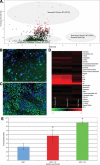Integrated chemical genomics reveals modifiers of survival in human embryonic stem cells
- PMID: 19074420
- PMCID: PMC3962308
- DOI: 10.1634/stemcells.2008-0596
Integrated chemical genomics reveals modifiers of survival in human embryonic stem cells
Abstract
Understanding how survival is regulated in human embryonic stem cells (hESCs) could improve expansion of stem cells for production of cells for regenerative therapy. There is great variability in comparing the differentiation potential of multiple hESC lines. One reason for this is poor survival upon dissociation, which limits selection of homogeneous populations of cells. Understanding the complexity of survival signals has been hindered by the lack of a reproducible system to identify modulators of survival in pluripotent cells. We therefore developed a high-content screening approach with small molecules to examine hESC survival. We have identified novel small molecules that improve survival by inhibiting either Rho-kinase or protein kinase C. Importantly, small molecule targets were verified using short hairpin RNA. Rescreening with stable hESCs that were genetically altered to have increased survival enabled us to identify groups of pathway targets that are important for modifying survival. Understanding how survival is regulated in hESCs could overcome severe technical difficulties in the field, namely expansion of stem cells to improve production of cells and tissues for regenerative therapy.
Figures







Similar articles
-
Small molecule screening with laser cytometry can be used to identify pro-survival molecules in human embryonic stem cells.PLoS One. 2013;8(1):e54948. doi: 10.1371/journal.pone.0054948. Epub 2013 Jan 29. PLoS One. 2013. PMID: 23383009 Free PMC article.
-
Opposing putative roles for canonical and noncanonical NFκB signaling on the survival, proliferation, and differentiation potential of human embryonic stem cells.Stem Cells. 2010 Nov;28(11):1970-80. doi: 10.1002/stem.528. Stem Cells. 2010. PMID: 20882529
-
Enhanced generation of human embryonic stem cells from single blastomeres of fair and poor-quality cleavage embryos via inhibition of glycogen synthase kinase β and Rho-associated kinase signaling.Hum Reprod. 2013 Oct;28(10):2661-71. doi: 10.1093/humrep/det309. Epub 2013 Aug 6. Hum Reprod. 2013. PMID: 23925393
-
Effect of ROCK inhibitor Y-27632 on normal and variant human embryonic stem cells (hESCs) in vitro: its benefits in hESC expansion.Stem Cell Rev Rep. 2010 Mar;6(1):86-95. doi: 10.1007/s12015-009-9107-8. Epub 2009 Dec 15. Stem Cell Rev Rep. 2010. PMID: 20013076
-
The ROCK inhibitor Y-27632 improves recovery of human embryonic stem cells after fluorescence-activated cell sorting with multiple cell surface markers.PLoS One. 2010 Aug 13;5(8):e12148. doi: 10.1371/journal.pone.0012148. PLoS One. 2010. PMID: 20730054 Free PMC article.
Cited by
-
Arrayed functional genetic screenings in pluripotency reprogramming and differentiation.Stem Cell Res Ther. 2019 Jan 11;10(1):24. doi: 10.1186/s13287-018-1124-6. Stem Cell Res Ther. 2019. PMID: 30635073 Free PMC article. Review.
-
Laminin-511 Activates the Human Induced Pluripotent Stem Cell Survival via α6β1 Integrin-Fyn-RhoA-ROCK Signaling.Stem Cells Dev. 2022 Nov;31(21-22):706-719. doi: 10.1089/scd.2022.0010. Epub 2022 Jul 26. Stem Cells Dev. 2022. PMID: 35726387 Free PMC article.
-
REST/NRSF Knockdown Alters Survival, Lineage Differentiation and Signaling in Human Embryonic Stem Cells.PLoS One. 2015 Dec 21;10(12):e0145280. doi: 10.1371/journal.pone.0145280. eCollection 2015. PLoS One. 2015. PMID: 26690059 Free PMC article.
-
Adapting human pluripotent stem cells to high-throughput and high-content screening.Nat Protoc. 2013 Jan;8(1):111-30. doi: 10.1038/nprot.2012.139. Epub 2012 Dec 20. Nat Protoc. 2013. PMID: 23257981
-
Increased lysis of stem cells but not their differentiated cells by natural killer cells; de-differentiation or reprogramming activates NK cells.PLoS One. 2010 Jul 16;5(7):e11590. doi: 10.1371/journal.pone.0011590. PLoS One. 2010. PMID: 20661281 Free PMC article.
References
-
- Thomson JA, Itskovitz-Eldor J, Shapiro SS, et al. Embryonic stem cell lines derived from human blastocysts. Science. 1998;282:1145–1147. - PubMed
-
- Adewumi O, Aflatoonian B, Ahrlund-Richter L, et al. Characterization of human embryonic stem cell lines by the International Stem Cell Initiative. Nat Biotechnol. 2007;25:803–816. - PubMed
-
- Darr H, Benvenisty N. Human embryonic stem cells: The battle between self-renewal and differentiation. Regen Med. 2006;1:317–325. - PubMed
-
- Baker DE, Harrison NJ, Maltby E, et al. Adaptation to culture of human embryonic stem cells and oncogenesis in vivo. Nat Biotechnol. 2007;25:207–215. - PubMed
-
- Herszfeld D, Wolvetang E, Langton-Bunker E, et al. CD30 is a survival factor and a biomarker for transformed human pluripotent stem cells. Nat Biotechnol. 2006;24:351–357. - PubMed
Publication types
MeSH terms
Substances
Grants and funding
LinkOut - more resources
Full Text Sources
Other Literature Sources

